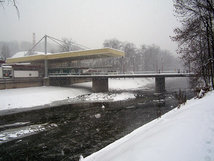Cieszyn - Český Těšín
Overview
Historical and geographical context
Before 1920, the towns of Cieszyn (Poland) and Český Těšín (Czech Republic) separated by the river Olse/Olza were one and the same town, Teschen, situated in the Austro-Hungarian Empire. After the First World Warn Teschen, was divided and the west bank became Czechoslovakian (taking the name “Český Těšín”) while the east bank became Polish (under the name Cieszyn). During the Second World War, the two towns were temporarily reunited before being separated once again in 1945.
Together, the towns constitute an important transport hub, and until 2007 was the location of the largest road border checkpoint (in terms of infrastructure and frequentation) between Poland and the Czech Republic. Today it represents the main motorway crossing point (E75) between northern and southern Europe. Since the two countries joined the Schengen Area, the inhabitants of the cross-border conurbation Cieszyn-Česky Těšin have been able to move freely back and forth across the border.
The population of the cross-border conurbation Cieszyn-Česky Těšin has reached 61,000 inhabitants, of whom 36,000 live on the Polish side. Since 2005 the population on the Czech side has been rising.


